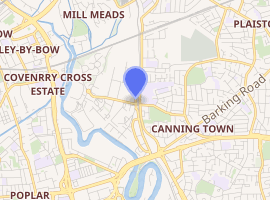Uniform Distribution and Accreditation Centre
The Uniform Distribution and Accreditation Centre or UDAC was a venue at the London 2012 Summer Olympics, located at 101 Stephenson Street in Canning Town, London.[1] It was opposite the Star Lane Docklands Light Railway station.[1]
| Uniform Distribution and Accreditation Centre | |
|---|---|

| |
| Former names | Canning Town Glass Works |
| Alternative names | UDAC |
| General information | |
| Status | Approved for demolition |
| Type | Warehouse |
| Location | Canning Town |
| Address | 101 Stephenson Street, Canning Town, London, E16 4SA |
| Town or city | London |
| Country | United Kingdom |
| Coordinates | 51°31′16.62″N 0°0′13.15″E |
| Completed | 1925 |
| Opened | 1925 |
| Demolished | 2012 |
History and design
The UDAC was a converted brick warehouse. It was built around 1925 and used to be the location of the offices of the Canning Town Glass Works.[1] In 2012, it was decorated with London 2012 banners and flags.[2] Outside of the UDAC was an office where people who had gone through the accreditation process could collect an Oyster card.[3] On 27 April 2012, the UDAC was officially opened by Lord Coe and Paul Deighton.[4]
Usage
The UDAC was the location for Olympic and Paralympic staff and volunteers to collect their accreditation passes and uniforms.[4] It also had an area to take photographs for accreditation passes. The uniform area consisted of changing rooms where many volunteers collected their uniforms; they criticised the UDAC for not having mirrors there, which the London Organising Committee of the Olympic and Paralympic Games (LOCOG) said was intended to speed up the process.[2] On 27 June, Prime Minister David Cameron visited the facility where he assisted the volunteers working at the UDAC.[5] He was heckled while giving a speech to the volunteers.[6]
After the Olympics
The UDAC was under the control of London Organising Committee of the Olympic and Paralympic Games (LOCOG) until September 2012 when they finished using it after the 2012 Paralympic Games. On 17 September Newham London Borough Council approved plans to demolish the facility and construct a series of industrial buildings in its place, intended as part of London's Olympic legacy.[1]
References
- "101 Stephenson Street" (PDF) (Press release). Newham London Borough Council. 2012-09-17. Retrieved 2013-01-03.
- Minard, Jenny (2012-05-15). "London 2012: Games Makers get in gear for the Olympics". BBC News. Retrieved 2013-01-03.
- Frequently Asked Questions (PDF). BTP. Retrieved 2013-01-03.
- "Coe and Deighton launch London 2012 Uniform Distribution and Accreditation Centre for 70,000 Games Makers". insidethegames.biz. 2012-04-27. Retrieved 2013-01-03.
- "British Prime Minister David Cameron works with London 2012 Olympic and Paralympic Games volunteers". Yahoo! News. 2012-06-27. Retrieved 2013-01-03.
- "David Cameron heckled by Olympic volunteer for 'crippling the poor'". Daily Telegraph (archived). 2012-06-27. Retrieved 2013-01-14.